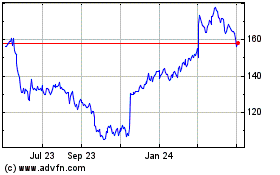By Sebastian Herrera
Retailers are promising to deliver more packages in just a day,
an attractive feature for shopping procrastinators like Jeff
Chin.
"Some people plan ahead, but some might not -- like myself,"
said Mr. Chin, a physician in the San Francisco Bay Area. "You
think of someone to get a gift for last minute, and if it comes the
next day, it's that much easier."
The scramble between Thanksgiving and Christmas, already a
hypercompetitive period for retailers, has gained a new twist, as
the nation's largest companies lure shoppers with faster delivery
offers. Pushing the delivery needle is Amazon.com Inc., which is
spending $1.5 billion in the fourth quarter to expand its free
one-day shipping program.
"We're adding new transportation capacity and putting more
selection," said Maria Renz, Amazon's vice president of global
retail experience. Customers say they continue to look for quicker
delivery options, even if they are planning ahead for the
holidays.
While many traditional retailers are struggling to keep pace,
Walmart Inc. and Target Corp. have held their ground by increasing
their delivery capabilities or getting shoppers to pick up online
orders at their stores. Both chains reported strong third-quarter
digital sales and increasing foot traffic.
Amazon, which pioneered two-day shipping more than a decade ago,
began in April to expand one-day shipping across the country and
add more eligible items. The Seattle tech giant is betting that
next-day shipping will boost its Prime memberships and strengthen
its grip on e-commerce sales.
More than 10 million items are available for next-day shipping
on Amazon's website, including cookware, videogame consoles and
other best-selling items. Amazon is hoping to grow the number to
more than 100 million items. The company declines to say how many
markets its one-day shipping covers except that the service is
available "coast to coast."
From November 2017 to this August, the share of Amazon packages
being offered for one-day shipping increased to 35.6% from 12.4%,
according to Rakuten Intelligence, which tracks Amazon
packages.
Amazon Chief Financial Officer Brian Olsavsky recently said
speedier shipping is causing Prime members to shop more. Sales in
Amazon's online stores rose 22% in the third quarter, double the
growth rate a year earlier, but the push to speed up shipping has
hurt its profit.
"The holidays will be a pretty good first test to apply the
logic, 'How much do people really need next-day shipping?'" Morgan
Stanley analyst Simeon Gutman said. Amazon is increasing its share
of overall retail spending, the bank estimated, and now captures 25
cents of every incremental dollar consumers spend, excluding cars,
fuels and restaurants.
Customers increasingly expect faster delivery speeds. A survey
this June by investment bank RBC Capital Markets of more than 2,000
shoppers showed that 64% of respondents were either "extremely" or
"very" interested in next-day shipping, compared with 43% in
2013.
Walmart's and Target's one-day services cover a much narrower
group of products than Amazon's. The companies both offer free
next-day delivery on orders of $35 or more, though Target says many
orders below the $35 threshold arrive in as soon as a day. Walmart
said its next-day delivery covers roughly 220,000 items. Target's
covers roughly 100,000 to 150,000 products, Mr. Gutman
estimated.
Unlike Amazon, which uses a network of hundreds of warehouses
and delivery centers to make fast shipping possible, Target takes
advantage of its 1,800-plus stores to quickly reach customers.
Walmart uses six fulfillment campuses throughout the country and
has more than 4,700 stores in the U.S. near customers.
Both companies say their next-day offers require "no membership
fee," taking aim at Amazon's $119 Prime annual membership cost,
which includes free one- and two-day shipping. Walmart began
offering next-day delivery in May. Its service now covers roughly
40 major metro areas.
This year, Target said it is offering free shipping "arriving in
as soon as one day" through Dec. 21. Amazon and Walmart haven't
said when their cutoff dates are. Target said it is also attracting
customers through same-day delivery in 250 markets.
Target Chief Executive Brian Cornell said the profitability of
the company's e-commerce sales has improved, as Target has shifted
its fulfillment system away from distribution centers to one based
on compiling orders from nearby stores.
Retail experts say the fourth quarter will test Amazon's
shipping capacity. In July, some Amazon shipments took longer than
the promised one- or two-day windows, as customers flooded the
company's site for its annual Prime Day shopping event.
Amazon in September said it would add 100,000 electric vehicles
to its network and has been leasing more airplanes to carry its
packages. Investment bank UBS Group AG estimated Amazon's one-day
shipping costs to total about $3.6 billion between its second and
fourth quarters this year and grow to roughly $6.1 billion next
year.
"Prime Day was the first proving ground for one day," said
Youssef Squali, an analyst with SunTrust Banks. "The fourth quarter
will be even bigger."
Write to Sebastian Herrera at Sebastian.Herrera@wsj.com
(END) Dow Jones Newswires
November 26, 2019 09:14 ET (14:14 GMT)
Copyright (c) 2019 Dow Jones & Company, Inc.
Target (NYSE:TGT)
Historical Stock Chart
From Mar 2024 to Apr 2024

Target (NYSE:TGT)
Historical Stock Chart
From Apr 2023 to Apr 2024
